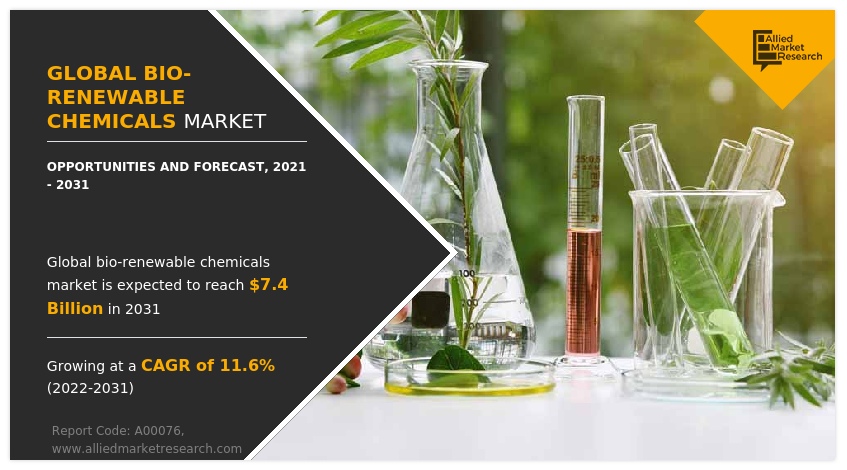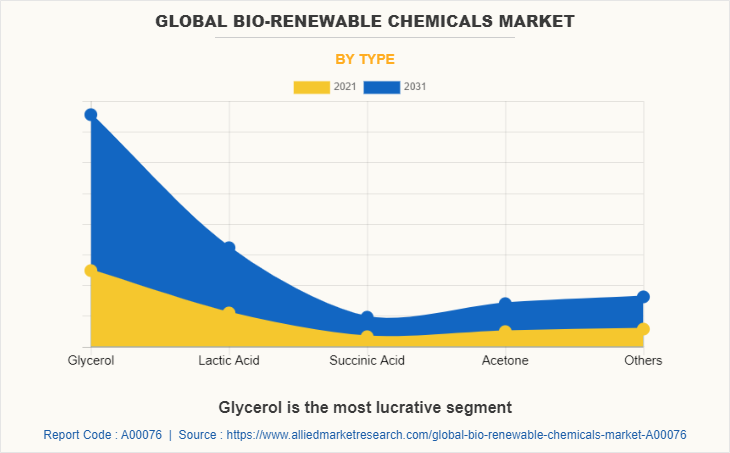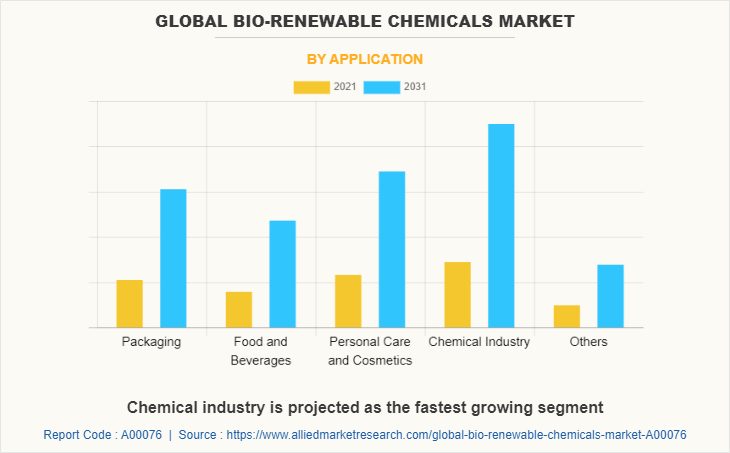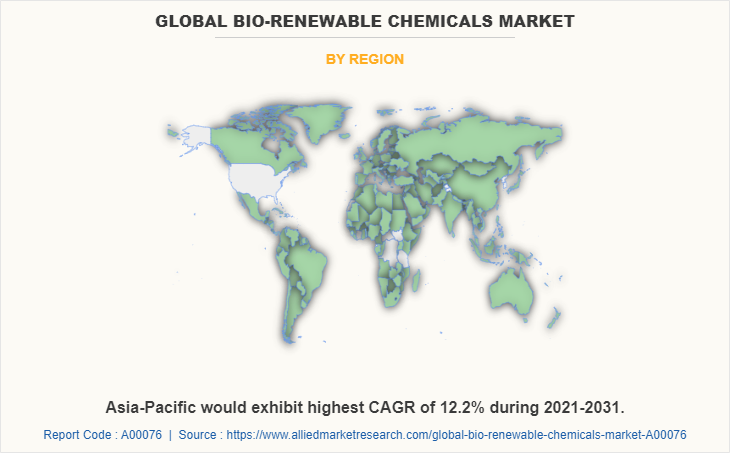Global Bio-Renewable Chemicals Market Research, 2031
The global bio-renewable chemicals market was valued at $2.5 billion in 2021, and is projected to reach $7.4 billion by 2031, growing at a CAGR of 11.6% from 2022 to 2031.
Report Key Highlighters
- The bio-renewable chemicals market is consolidated in nature among companies such as Solvay, BASF SE, Unilever PLC, Cargill, Incorporated, DuPont de Nemours, Inc., and Amyris that hold significant share in the market.
- The study covers key strategies such as acquisition, agreement, collaboration, joint venture, partnership, and product launch of manufacturers for a better understanding of bio-renewable chemicals market.
- The latest trends such as the development of bio-renewable chemicals by key manufacturers across various regions has been covered in the report. For instance, Gevo, Inc., has developed a catalytic process that uses renewable raw materials to produce isoprene, which is a key chemical building block for producing rubber and rubber products. This strategic product launch has strengthened Gevo's bio-based renewable energy chemicals.
- The report also covers the key regulation analysis of bio-renewable chemicals market across North America, Europe, Asia-Pacific, and LAMEA regions.

Bio-renewable chemicals are referred as chemicals that are derived from renewable sources, including agricultural waste, agricultural feedstock, biomass, microorganisms, and organic waste products. Bio-renewable chemicals have less carbon footprint as compared to traditional petroleum-based chemicals. Some examples of commonly used bio-renewable chemicals include bio-glycerol, acetone, propanol, succinic acid, lactic acid, and others.
Surge in awareness for sustainability and eco-friendly activities have led the environmental regulating agencies of both developed and developed economies to increase efforts toward reducing environmental footprints. Several agencies such as the United States Environmental Protection Agency (U.S.EPA), State Pollution Board (SPB), Central Pollution Control Board (CPCB), European Union (EU), and others are constantly engaged in reducing environmental footprints by imposing various acts as regulations. For instance, the section 111 of the Clean Air Act regulates the emission of greenhouse gases from industries and impose independent regulation considering the severity index of emitted gases generated by processing of petrochemicals.
Petrochemicals create extraordinary amounts of pollution. Some of the most harmful pollutants include benzene, ethylene oxide, formaldehyde, chloroprene, PFAS, vinyl chloride, and trichloroethylene. Bio-renewable chemicals are produced from renewable bio-based feedstocks that make them clean and safe to use considering the environmental aspects. Furthermore, the price of petrochemicals varies significantly owing to the fact that petrochemicals are derived from petroleum which is a highly volatile commodity when price is considered. These aforementioned factors have led the bio-renewable chemicals to gain traction over petrochemicals in various end-use sectors; thus, fueling the growth of the bio-renewable chemicals market.
Furthermore, factors such as increase in technological advancements, rise in dynamics of renewable energy, improvements in economics of renewable, and growing concern for environmental protection activities have led consumers to shift towards using products derived from renewable resources. Furthermore, the customers are becoming aware about the benefits associated with the use of renewable-sourced products as compared to the synthetic ones. For instance, the use of renewable resources causes less air pollution, reduces dependency on synthetic processes, creates economic development and jobs in manufacturing, installation, and others.
Moreover, governments of both developed and developing economies are promoting the use of renewable resources. For instance, according to a report published by the Indian Ministry of New and Renewable Energy in July 2022, the government has permitted foreign direct investment (FDI) up to 100% in the renewable sector. Furthermore, setting up of Ultra Mega Renewable Energy Parks to provide land and transmission to RE developers on a plug and play basis. These events have promoted the use of bio renewable chemicals for developing and manufacturing a wide range of renewable chemicals; thus, boosting the growth of the bio-renewable chemicals market.
However, the overall price of bio-renewable chemicals depends upon factors such as costs of feedstock, energy requirements, and marketability of products. These factors have made bio-renewable chemicals expensive as compared to synthetic chemicals. Furthermore, high processing costs and complex manufacturing processes leads to an increase in the overall prices of bio-renewable chemicals. Also, the manufacturing of bio-renewable chemicals requires big machinery and skilled workforce. These factors directly influence the price of bio-renewable chemicals and make them costlier. Moreover, when compared to synthetic counterparts, some bio-renewable chemicals have proved to be exceedingly expensive. This factor may restrain the growth of the bio-renewable chemicals during the forecast period.
In addition to this, lack of consumer understanding and low purchasing power of these chemicals in Asia-Pacific and African region may restrict the consumption of bio-renewable chemicals among various end use sectors; thus, hampering the growth of the bio-renewable chemicals market.
On the contrary, factors such as preservation of the environment, health benefits, and ethical aspects of the production process have surged the popularity of environment friendly products. Furthermore, the increasing regulatory pressure imposed by several environment protection agencies such as the United States Environmental Protection Agency (U.S.EPA), Central Pollution Control Board (CPCB), European Union (EU), and others have led the chemical manufacturers to make rapid transition towards using renewable resources-based raw materials. Bio-renewable chemicals being an environmentally-friendly product poses less threat to environment. Moreover, the production and trading of bio-renewable chemicals is duty free in many countries. These factors have surged the popularity of bio-renewable chemicals in various end use sectors; thus, creating lucrative opportunities for the market.
The global bio-renewable chemicals market is segmented into type, applicationand region. On the basis of type, the market is categorized into glycerol, lactic acid, succinic acid, acetone, and others. By application, it is classified into packaging, food & beverages, personal care & cosmetics, chemical industry, and others. Region-wise, the market is studied across North America, Europe, Asia-Pacific, and LAMEA.

By type, the glycerol dominated the global market and is anticipated to grow at a highest CAGR of 11.8% during the forecast period. The increasing disposable income coupled with awareness for skin care activities have led the cosmetic sector in both developed and developing economies to witness a significant growth where glycerin is widely used as a denaturant, fragrance ingredient, hair conditioning agent, humectant, and others in various cosmetic and personal care products. This may act as one of the key drivers responsible for the growth of the bio-renewable chemicals market for glycerin type.
Furthermore, factors such as increase in R&D activities, low cost of production, and a huge workforce availability have led the pharmaceutical sector to witness a significant growth where glycerol is used to improve smoothness and taste of medicines. For instance, according to a report published by India Brands Equity Foundation, Indian drugs and pharma exports reached $5.78 billion between April 2021- June 2021. This is anticipated to increase the demand for bio-renewable chemicals market for glycerol type in the growing pharmaceutical sector.

By application, the chemical industry segment was the largest revenue generator, and is anticipated to grow at a CAGR of 11.6% during the forecast period. Growing population coupled with rise in demand for a wide range of consumer goods has surged the establishment of chemical manufacturing units in both developed and developing economies wherein bio-renewable chemicals are used to produce a wide range of consumer goods. This factor may act as one of the key drivers responsible for the growth of the bio-renewable chemicals market during the forecast period.
Furthermore, rising awareness for sustainability and environmental protection activities have led the major chemical manufacturing companies to shift their production from synthetic chemicals towards bio-renewable chemicals. This factor may surge the utilization of bio-renewable chemicals in the growing chemical manufacturing sector; thus, creating remunerative opportunities for the market.

The Asia-Pacific bio-renewable chemicals market is projected to grow at the highest CAGR of 4.7% during the forecast period and accounted for 43.5% of bio-renewable chemicals market share in 2021. The growth of the bio-renewable chemicals market in Asia-Pacific is majorly driven by the largest economies such as India and China; this is attributed to rise in packaging industry, textile, personal care & cosmetics, and other sectors in the Asia-Pacific region.
China’s packaging sector is increasing rapidly which has forced the bioplastic manufacturers to produce high-quality bioplastics made from bio-renewable chemical such as poly lactic acid. Furthermore, the food & beverage sector is growing rapidly where bio-renewable chemicals are used as food additives, food packaging, and other sectors. For instance, according to a report published by Interpack in 2021, the consumption of food packaging in China is expected to increase from 399,858 million packaging items in 2018 to 447,066 million in 2023. This may enhance the demand for bio-renewable chemicals in the growing food packaging sector.
Furthermore, the personal care & cosmetics sector in India is growing at a rapid pace owing to factors such as rise in disposable income couples with increasing self-grooming activities. For instance, according to a report published by India Brands Equity Foundation in 2022, the market size of India's beauty, cosmetic and grooming market will reach $ 20 billion by 2025. This is projected to increase the demand for bio-renewable chemicals such as glycerin, and others that are used in producing various cosmetics formulations; thus, fueling the market growth.
In addition, countries such as Japan have a large proportion of elderly population. The increasing awareness for looking young have surged the demand for various anti-ageing creams wherein bio-renewable chemicals such as glycerin, and others are used as a major moisturizing agent. This factor may enhance the performance of the bio-renewable chemicals market in the Asia-Pacific region.
The major companies profiled in this report include Gevo, Inc., Vizag Chemical, Solvay, BASF SE, Unilever PLC, ZeaChem, Cargill, Incorporated, DuPont de Nemours, Inc., Elevance Health, and Amyris.
IMPACT OF COVID-19 ON THE GLOBAL BIO RENEWABLE CHEMICALS MARKET
- The bio-renewable chemicals market had been negatively impacted due to the wake of the COVID-19 pandemic, owing to its dependence on the food & beverage, textile, and other industrial sectors. According to a report published by the Organization for Economic Co-operation and Development (OECD), decreased consumer demand has put downward pressure on the prices and production of chemical-based products.
- However, several key players such as Cargill, BASF, DuPont, and others are constantly engaged in increasing their production and seeking for new investment opportunities amid the COVID-19 situation. For instance, BASF has been producing commercial production of bio-butanediol and has secured rights to produce bio-butanediol up to 75,000 tons per annum. These factors have fueled the growth of the bio-renewable chemicals post COVID-19 period.
Key Benefits For Stakeholders
- This report provides a quantitative analysis of the market segments, current trends, estimations, and dynamics of the global bio-renewable chemicals market analysis from 2021 to 2031 to identify the prevailing global bio-renewable chemicals market opportunities.
- Market research is offered along with information related to key drivers, restraints, and opportunities.
- Porter's five forces analysis highlights the potency of buyers and suppliers to enable stakeholders to make profit-oriented business decisions and strengthen their supplier-buyer network.
- An in-depth analysis of the global bio-renewable chemicals market segmentation assists to determine the prevailing market opportunities.
- Major countries in each region are mapped according to their revenue contribution to the global market.
- Market player positioning facilitates benchmarking and provides a clear understanding of the present position of the market players.
- The report includes an analysis of the regional as well as global bio-renewable chemicals market trends, key players, market segments, application areas, and market growth strategies.
Global Bio-Renewable Chemicals Market Report Highlights
| Aspects | Details |
| Market Size By 2031 | USD 7.4 billion |
| Growth Rate | CAGR of 11.6% |
| Forecast period | 2021 - 2031 |
| Report Pages | 483 |
| By Type |
|
| By Application |
|
| By Region |
|
| Key Market Players | Amyris, Cargill, Incorporated, Vizag Chemical, Elevance Health, BASF SE, DuPont de Nemours, Inc., Gevo, Inc., ZeaChem, Unilever plc, solvay |
Analyst Review
The global bio-renewable chemicals market is expected to exhibit high growth potential, owing to its use in the production of bio-butanediol, poly lactic acid, bio-polymers, polytetramethylene ether glycol, thermoplastic polyurethane, polybutylene terephthalate, and others. Bio-renewable chemicals are expected to face tough competition from fossil-based chemicals. However, lower cost and optimum properties of bio-renewable chemicals compared to fossil-based chemicals helped the market to gain high traction during the forecast period. Moreover, the availability of abundant feedstock and biomass is an added benefit for the production of bio-renewable chemicals. It is further expected that in few years bio-renewable chemicals can completely replace fossil-based chemicals, owing to rise in concerns over sustainability and surge in adoption of eco-friendly products.
In addition, bio-renewable chemicals are used in the production of polybutylene terephthalate (PBT), and other solvents. Owing to the development of lightweight vehicles across the world, the adoption of PBT has increased drastically in the production of fenders, bumpers, front & rear end fascia, and spoilers. Moreover, in the automotive and transportation sectors, PBT offers weight reduction, energy absorption, shock absorption, and it reduces the risk of explosion in fuel tanks. The presence of big players in the bio-renewable chemicals market such as BASF SE, Cargill, DuPont, and others creates immense opportunity for the development in the production process of products. Healthy competition in the market further leads to the quality product to end users. These factors are expected to drive the global bio-renewable chemicals market during the forecast period.
Low environmental footprint as compared to petrochemicals and rising demand for chemicals derived from renewable sources are the upcoming trends of the global bio-renewable chemicals market.
Chemical Industry is the leading application of the global bio-renewable chemicals market.
The Asia-Pacific bio-renewable chemicals market accounted for 43.5% of bio-renewable chemicals market share in 2021
The global bio-renewable chemicals market was valued for $2.4 billion in 2021 and is estimated to surpass $7.3 billion by 2031, exhibiting a CAGR of 11.6% from 2022 to 2031
Gevo, Inc., Vizag Chemical, Solvay, BASF SE, Unilever PLC, ZeaChem, Cargill, Incorporated, DuPont de Nemours, Inc., Elevance Health, and Amyris are the top companies that hold the market share in global bio-renewable chemicals market
Loading Table Of Content...



